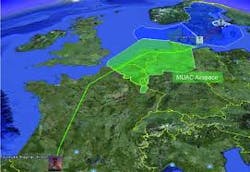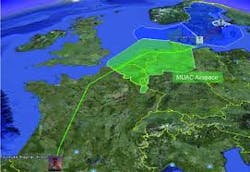Aerospace technology firms partner to advance 4D navigation within SESAR
ORLANDO, Fla., 25 April 2013. 4D Trajectory is a key part of the Single European Sky ATM Research (SESAR European air traffic management system), explained an Airbus executive during the 2013 General Session of the AEEC (Airlines Electronic Engineering Committee) in Lake Buena Vista, Fla., this week.
Integral to SESAR, 4D Trajectory is intended to bring about a move from radar to 4D capabilities in air traffic control/air traffic management (ATC/ATM), he described. The main benefits of 4D Trajectory are:
- get as close as possible to the user-preferred trajectory (shortest distance),
- have common and shared representation of the flight info between the aircraft and the ground, and
- make the best use of technologies and procedures (FMS, Airles Operating Centers, weather prediction, etc.).
Initial 4D (I-4D) is first step to 4D navigation, the Airbus spokesperson explained. The I-4D effort involves:
- the sharing and synchronization of airborne and ground trajectory, and
- flying to time constraints to optimize sequences as defined by ATC.
Industry leaders joined forces and technologies to perform an I-4D demo. Flight partners included:
- Airbus, providing the aircraft;
- Thales and Honeywell providing the unified flight management system;
- Eurocontrol and Noracon air navigation service providers (ANSPs); and
- support from Thales and Indra.
The European SESAR community is looking forward to full use of 4D navigation in the next 10 years. “Thanks to technology partners working complementary fields, I-4D has become a reality,” notes a representative.



